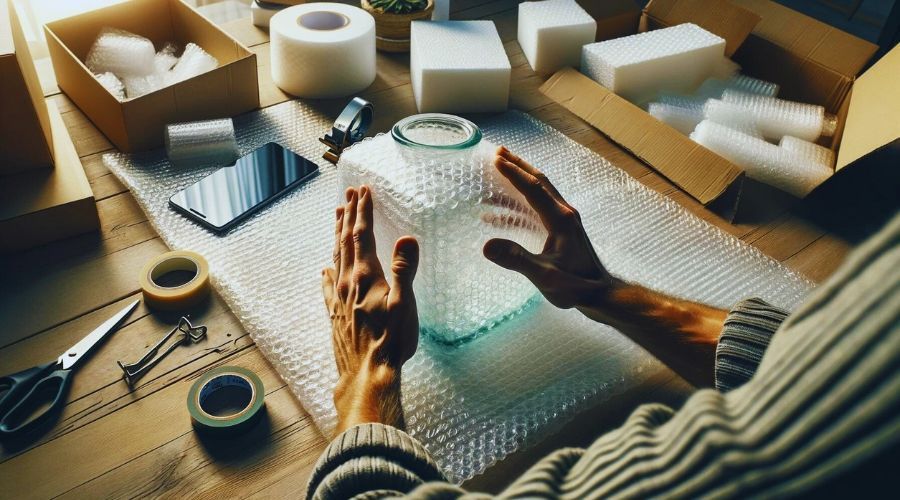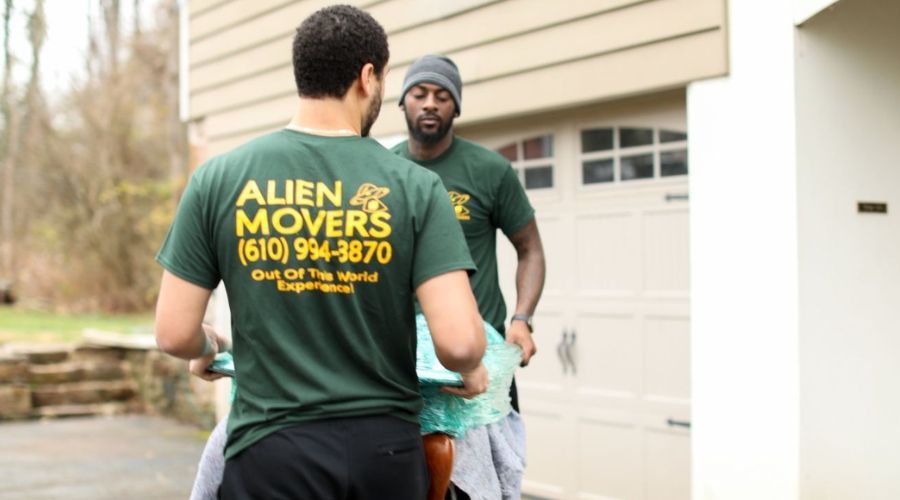
By: Carson Williams at: March 4, 2024
Moving, whether local moving or long-distance, always comes with its share of challenges. Among these, ensuring the safe transit of your fragile items stands out as a task that requires special attention and care. Alien Movers, your trusted full-service Philadelphia moving company, has compiled a comprehensive guide to help you navigate the complexities of moving your most delicate possessions. Read on to arm yourself with knowledge and strategies that will make your next local move smooth and stress-free.
Embarking on the Journey: The Importance of Proper Packing
Alien Movers champions the cause of protecting your valuables. Our experience has shown that the right techniques and materials can make all the difference. This guide serves to pass on that wisdom to you, ensuring that when you embark on your local move, you do so with confidence, knowing that your fragile items are as protected as possible.
Pre-Move Essentials: Getting Ready
Before you dive into the packing process, a few preparatory steps can set the foundation for a smooth move:
- Inventory: Take stock of all your belongings and highlight which items are fragile. Creating this inventory not only helps you organize but also ensures that you give extra attention to these items during the move.
- Choosing the Right Supplies:
- Boxes: Opt for sturdy, high-quality boxes that can bear the weight of your items. Consider specialized boxes for certain items, like dish packs for your kitchenware or picture boxes for artwork and mirrors.
- Wrapping Materials: Bubble wrap, packing paper, and even old newspapers can provide a protective layer to your fragile items. Each material has its place, with bubble wrap being ideal for extra cushioning and packing paper for wrapping and padding.
- Other Protective Supplies: Packing peanuts and foam pads can fill in the gaps in boxes, preventing items from shifting and colliding during transport.
- Insurance: Despite all precautions, accidents can happen. Choosing the right insurance coverage for your move gives you an added layer of protection against unforeseen damages.
The Art of Packing: Techniques and Strategies
Packing your fragile items demands a blend of patience, care, and strategy. It's not merely about wrapping and placing things in boxes but doing so in a way that shields them from the stresses of the move. Here are some tried and tested techniques for safeguarding your most delicate possessions.
Step-by-Step Guide to Packing Glassware
- Prepare the Box: Reinforce the bottom of the box with plenty of tape for added strength. Place a layer of bubble wrap or packing peanuts at the bottom for cushioning.
- Wrap Each Item: Wrap each glass item individually with packing paper, securing it with tape. For extra protection, consider using bubble wrap as an outer layer.
- Positioning in Box: Place heavier items at the bottom and lighter ones on top. Ensure that there is no wiggle room by filling gaps with crumpled packing paper or peanuts.
- Final Touches: Once the box is packed, add another layer of cushioning on top before sealing it. Mark the box as "Fragile" on multiple sides.
Safeguarding Your Electronics: Tips and Tricks
- Original Boxes: If possible, pack electronics in their original boxes, which are specifically designed for their safe transport.
- Backup Data: Backup all your data before moving.
- Remove Batteries and Cables: Prevent damage by removing batteries and cables. Pack these separately, labeled clearly.
- Extra Protection: Use anti-static bubble wrap to protect electronics from static electricity. Fill the box with foam inserts or peanuts to prevent movement.
Protecting Artwork and Mirrors: A How-To
- Padding: Wrap artwork and mirrors in bubble wrap, securing the wrapping with packing tape.
- Cardboard: Add an extra layer of protection by cutting pieces of cardboard to size and taping them over the bubble wrap.
- Special Boxes: Use telescoping cardboard boxes, which can be adjusted to fit the size of your artwork or mirror precisely.
- Vertical Packing: Store these items vertically in the moving truck to reduce the risk of damage.
Special Considerations for Antique Furniture
- Disassemble if Possible: Remove legs, drawers, or any other parts that can be detached. Wrap and label these parts separately.
- Cover Surfaces: Use moving blankets or furniture pads to cover and protect the surfaces of your furniture.
- Secure with Stretch Wrap: Use stretch wrap to hold the blankets or pads in place, adding an additional layer of protection.
DIY vs. Professional Packing Services: Making the Choice
Deciding between packing your fragile items yourself or hiring professionals depends on several factors, including the value of your items, your budget, and your confidence in your packing abilities. Alien Movers offers specialized packing services, where our experts employ industry-leading techniques to ensure your valuables are protected through every phase of the move.
Packing your fragile items doesn't have to be a daunting task. With the right approach and attention to detail, you can ensure their safe arrival at your new home. Should you prefer to entrust this job to professionals, Alien Mover's team is at your service, bringing years of experience and a gentle touch to the task of protecting your most precious belongings.
On the Move Day: Ensuring Safe Transit
Moving day has finally arrived, and it’s time to ensure that all your meticulous packing pays off with a safe transit for your fragile items. Here are key strategies and precautions to keep in mind as you load and transport your belongings.
Proper Loading Techniques for Fragile Items
- Heaviest Boxes First: Start with the heaviest boxes on the truck’s floor, nearest to the cab. It creates a stable base and prevents lighter, fragile items from being crushed.
- Keep Fragile Boxes Separate: Designate a specific area of the truck for fragile items only. This area should be away from easily shifting objects.
- Avoid Stacking: Whenever possible, avoid stacking boxes containing fragile items. If you must stack, ensure only light boxes are placed on top, and they are securely strapped to prevent falls.
- Use Moving Blankets: For extra protection, drape moving blankets over fragile items. Secure these blankets with bungee cords or straps to prevent movement.
Maximizing the Security of Your Items in the Moving Truck
- Strategic Positioning: Place fragile items between mattresses, sofas, or other padded furniture whenever possible. These items can serve as additional buffers against shocks and vibrations.
- Fill the Gaps: Use pillows, cushions, and soft toys to fill gaps between boxes, thereby minimizing movement within the truck.
- Vertical Alignment: Mirrors, artwork, and TVs should be positioned vertically, mirroring their natural orientation, to withstand pressure better and decrease the likelihood of damage.
Alien Mover’s Protocol for Safe Local Transports
Arrival and Unpacking: The Final Check
The move is almost complete, but your role in safeguarding your fragile items isn’t over yet. Unpacking them carefully is just as important as packing and transporting. Following a mindful and systematic approach can prevent any last-minute damages. Here’s how to proceed
Unpacking Tips for Fragile Items
- Set Up a Clear Workspace: Before you begin unpacking, ensure you have a spacious and clear area to reduce the risk of accidental drops or knocks.
- Use the Right Tools: Have scissors or a box cutter handy to open boxes without applying excessive force. Remember to cut away from your body and the contents of the box.
- Unpack One Box at a Time: Resist the temptation to open all boxes at once. Focus on one box, completely unpack it, and then move onto the next to avoid clutter and confusion.
- Inspect as You Go: As you remove items, inspect them for any signs of damage that might have occurred during the move. If you do find damage, documenting it with photos can be critical, especially for insurance claims.
- Prioritize Placement: As you unpack fragile items, immediately place them in their new designated spots to minimize handling and the risk of damage.
What to Do in Case of Damage: Steps and Recommendations
No matter how careful you are, damage can sometimes occur. Here’s what to do if you discover that one of your items has been damaged during the move:
- Document Everything: Take detailed photos of the damage from multiple angles. This will be important for insurance purposes.
- Check Your Inventory List: Cross-reference the damaged item with your pre-move inventory list to confirm its condition before the move.
- Contact Your Moving Company or Insurance: As soon as possible, get in touch with Alien Movers or your insurance provider to report the damage and understand the next steps for your claim.
- Review Your Insurance Coverage: Understand what your moving insurance covers and the amount you are entitled to for the damaged item.
Beyond the Move
Moving fragile items is a delicate task that extends beyond simply transporting them from Point A to Point B. It involves thoughtful preparation, careful packing, vigilant transporting, and attentive unpacking. By following the strategies outlined in this guide, you’ve equipped yourself with the knowledge to protect your most delicate possessions during a local move.
Alien Movers is committed to ensuring your valuables are treated with the care and respect they deserve. Our comprehensive moving services, grounded in years of experience and adherence to safety protocols, make us your trusted partner for a stress-free move. If you're planning a local move in Philadelphia and worry about transporting fragile items, remember that we're here to help every step of the way.
We hope this guide has empowered you to move your fragile items with confidence. Remember, preparation is key, and choosing the right moving partner can make all the difference. Safe travels on your moving journey!
Ready to plan your hassle-free move with Alien Movers? Contact us today for more information.
Share this article










